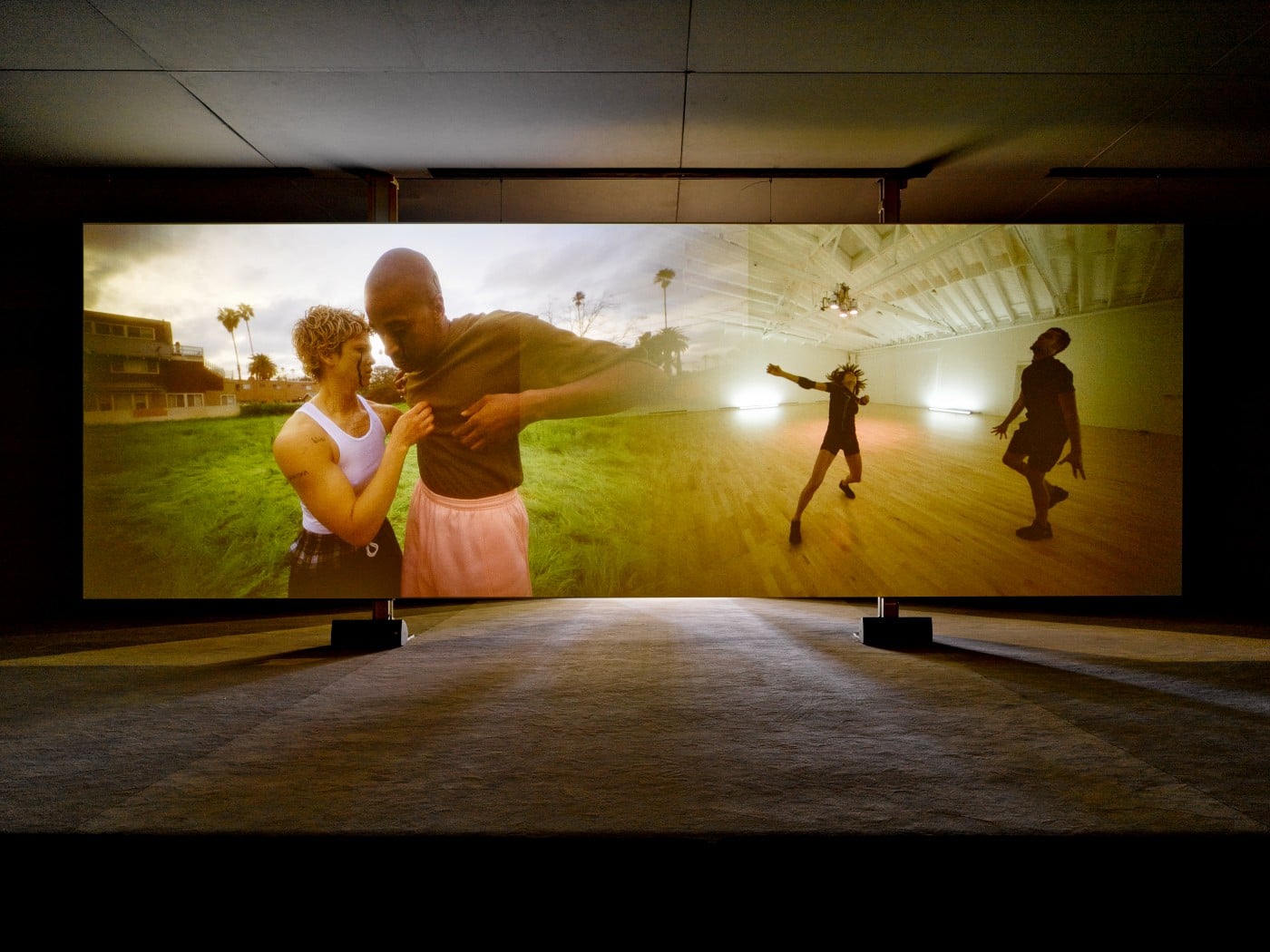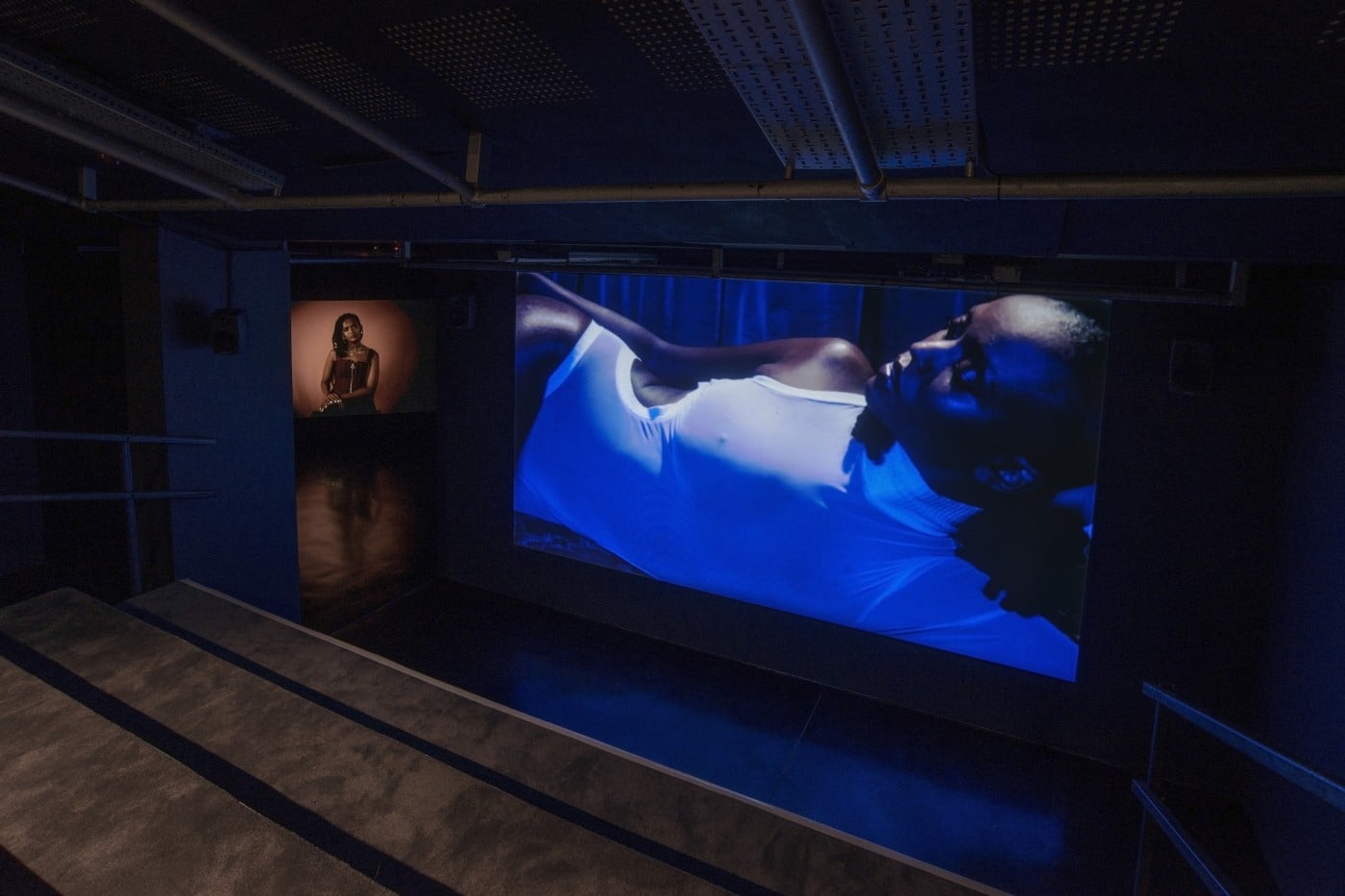
Wu Tsang, We hold where study (2017), 2-channel video with sound, duration: 18:56 min, dimensions variable. Installation view: “Devotional Document 2” at Kunsthalle Munster 27.05.2017–01.10.2017. Courtesy of the Artist and Galerie Isabella Bortolozzi, Berlin. Commissioned by curator Nadja Argyropoulou for Polyeco Art Initiative. Photo: Roman Mensing.
FACT’s current season Refuge aims to explore the idea of ‘safe space’. To mark this season, as part of Homotopia Festival, FACT have brought L.A based filmmaker Wu Tsang, who’s work focuses on the trans queer community, to Liverpool.
Entering gallery one plunges you down a pitch black corridor, before thrusting you into a large space. As your eyes adjust you can see the floor is littered with large cushions in front of two huge screens, on which dancers jostle and intertwine. You entered struggling to adjust to Wu Tsang’s reality, but leave feeling it as a breath of fresh air, now struggling to adjust to the outside world. The exhibition continues upstairs, where the invigilator guides you with a flashlight onto a platform positioned in front of the main screen, while diagonally across, on a second screen, musician Kelela stares out. She holds herself with strength and conviction only moving slightly throughout the film, staring out at you.
The first work is the UK premiere of Wu Tsang’s new commission: We Hold Where Study. On the left hand side you are shown a plot of overgrown grass in a residential area, whilst on your right your eyes behold an atmospheric blue and red lit empty studio. The line is smudged between the two. Sometimes a patch of grass finds way into the polished wooden floor; on other occasions a dancer jumps from an internal space, to land in external surroundings.
Tsang’s film aims to depict identities that have been deemed invisible or impossible in society, locating them in a world of contradictions: natural or manufactured, soft or hard. The dancers movements flit from harmonious to conflicting, a seemingly soft caring touch turns quickly to forceful one. These juxtaposing themes portray the struggle of identity when it comes to blackness, transness and queerness, much like the work of Moten and Stefano Harvey, particularly the essay ‘Leave Our Mikes Alone’. The subjective camera work that twirls from earth to sky, is sometimes dizzying as it dances as much as the agents of the film. While jagged, raw, and emotional, We Hold Where Study’s minimalist aesthetic, fluid camera work, beautiful choreography and resonating score makes the piece simultaneously hypnotizing and immersive. Wu Tsang invites you into their space. You won’t feel any desire to leave it.

Wu Tsang, Under Cinema (2017). Installation view: Under Cinema at FACT, UK (26.10.2017 –18.02.2018). Courtesy of the Artist and Galerie Isabella Bortolozzi, Berlin. Photo: Jon Barraclough.
Whilst Wu Tsang’s first piece tackles the idea of safe space conceptually, the second: Under Cinema is a very literal piece documenting Kelela’s construction of her debut album.
Under Cinema allows its audience to feel a part of the creative process undergone when creating an album. But more importantly Kelela gives poignant insights into the cultural appropriation of Black music by the Pop industry:
“So much of Pop music is rooted in R&B, in Black Music. In art it’s coming from a painful experience. In Pop I think what’s happened is we have a lot of people connecting to the sound of pain without actually processing the people’s pain that it comes from and the people themselves.”
Kelela explains how her blackness is treated in music industry as “cultural currency”, which means that as a musician and a black woman she is constantly assessing whether people’s interest is based in using her culture. In this documentation, through Wu Tsang’s footage we are given an undisputable example of a safe space. The piece includes parts of Kelela’s appearance at Brooklyn’s Afropunk Festival, a space dedicated to celebrating and unifying the cultural cornerstones of AFROPUNK through music, film, skate, and art. Kelela explains that at her gigs the front row is made up of her black queer fans, whereas at Afropunk the audience is a sea of front rows. Throughout this production you cannot help but feel Kelela’s omnipresence, created by Wu Tsang’s use of two-channel video. Both films reach out to connect with you, fixing you to the seat, commanding your attention.
Wu Tsang’s stylistic choices, such as the continual use of two-channel colour HD video and alluring cinematography makes a trip to FACT Gallery an extremely delectable one. Both pieces explore the concept of safe space for the black and queer communities in extremely different but equally satisfying ways. Tsang’s work makes a distinct impression and it’s graceful nature will have you leaving awestruck.
Review by: Billie Walker
Under Cinema continues at FACT until February 18th. For more info visit their website.
Filed under: Art & Photography

Comments